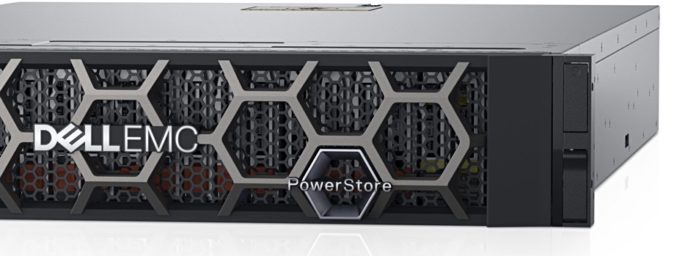Dell Technologies has announced a PowerStore 500 entry-level system and updated PowerStore software with performance enhancements.
Jeff Boudreau, GM of Dell Technologies infrastructure solutions group, proclaimed today: “PowerStore is the fastest-growing new architecture in Dell history. With today’s announcements, we’ve made PowerStore faster and smarter while making it easier for a broader range of businesses to get started with the platform.”
PowerStore, Dell EMC’s mid-range unified file, block and VVOL storage array, made its debut in May 2020. The product line up is the successor to the existing Unity product line and its capabilities converge with the XtremIO all-flash arrays. Dell EMC had already folded the functionality of Compellent SC array – yet another midrange product – into the Unity line. PowerStore sales were initially slow and HPE, NetApp and others played down its chances as they pounced on a product transition opportunity.
However, Dell in February reported that PowerStore was positioned for strong growth, and would help return company-wide storage revenues to growth after two years of decline. Today the company, said it has experienced fourfold PowerStore sales growth Q-on-Q in the most recent quarter, without providing any figures for us to compare.

Let’s take a run-through today’s Powerstore announcements.
Powerstore software
PowerStore OS 2.0 adds:
- Performance improvements with up to 25 per cent more IOPS on PowerStore 5000 with a 70/30 random read/write mix with 8K block size and writes up to 60 per cent faster.
- NVMe over Fibre Channel (NVMe-FC) using 32Gbit/s Fibre Channel, with no additional hardware needed, providing end-to-end NVMe access,
- The AppsON run-virtual-machines-in-the-array feature has been extended to operate in clusters of up to four PowerStores with apps moveable between the nodes.
- A single stretched vVols container spans appliances and presents a single pool of storage available to all cluster nodes.
- A 4:1 average data reduction rate, with hardware assist and larger dedupe cache, guaranteed across customer applications with data reduction limited at times of the heaviest IO. Machine learning capabilities track and manage deduplication at times of the heaviest IO, providing up to 20 per cent more IOPS during peak bursts with no impact on data reduction ratios.
- Better high-availability with dual-parity Dynamic Resiliency Engine (DRE) protecting against dual drive failures and needing up to a claimed 98 per cent less management effort than traditional RAID configurations.
- Smarter tiering with metadata stored on Optane storage class memory (SCM) and data on NVME drives, speeding metadata access for up to 15 per cent lower workload latency with just a a single Optane drive.
The AppsON extension provides additional compute power for storage-intensive applications at the edge in areas such as healthcare and big data analytics.
PowerStore 500
Dell EMC has added a lower-cost, all-flash PowerStore 500 to the existing 1000, 3000, 5000, 7000 and 9000 models. They all have dual controllers, each with two Intel CPUs and increasing core counts up the range. The 2 rack unit 500 has a single Intel CPU per controller.

It also has the lowest maximum raw capacity, at 384TB. The next model in the range, the 1000, has 898.6TB. A cluster of four PowerStore 500s supports up to 1.2PB of raw capacity, with the 4:1 dedupe bulking that out to 4.8PB.
Customers can add PowerStore 500 to existing PowerStore clusters.
An Anytime Upgrades feature lets customers enhance or expand their PowerStore performance and capacity after 180 days of ownership. This requires purchase of a minimum 3-year ProSupport Plus with Anytime Upgrade Select or Standard add-on option at point of sale to qualify.
The non-disruptive PowerStore software updates will be available for download on June 10, 2021 and the PowerStore 500 will be available for ordering on May 4, 2021 with shipments starting June 10, 2021.
Comment
The combination of a performance-tuned IO stack, Optane metadata caching, NVMeFC access and a lower cost PowerStore 500 will significantly add to the competitive pressure that Dell EMC can bring to the mid-range array arena. We might expect that the win rates against PowerStore seen by HPE, Hitachi Vantara, IBM, NetApp, Pure Storage and others will take a downturn.








